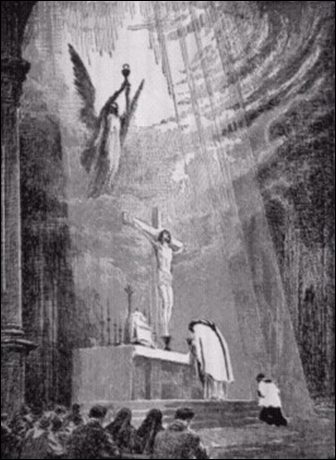Ignatians not only enact the Holy Sacrifice of the Mass according to the classic Roman liturgy, truly the “Mass of the Ages” (termed the “Extraordinary Form of the Roman Liturgy” in Summorum Pontificum by Pope Benedict XVI) but venerate it, placing it and the rest of the traditional liturgy at the source of their asceto-mystical determination, i.e. spirituality.
Ignatians will be ordained to the priesthood according to this most ancient rite, having reached that glorious day by ascending through each of the minor orders, and will pro-actively promote the knowledge and love of the ancient rite.
Why Ignatians Venerate the Traditional Latin Mass: The On-Going Revolution
Catholicism, in its essence, is the revolution of the Cross because it is the prolongation of the God-Man’s action who, on Calvary, won the crucial victory in the war to destroy the power of Satan over mankind.
Nevertheless, this war will continue until the world’s last moment since Satan will never cease to “act in the world out of hatred for God and His Kingdom” (Catechism of the Catholic Church, n. 395).
Since God has willed that Christians use their intelligence and freedom, supernaturally powered by grace, to establish His reign, there must be consequently an on-going revolution against “the whole world [that] is under the power of the evil one” (1 John 5:19)
This revolution must explode first of all in the heart and mind of the individual before a social revolution occurs.
Although conditioned by man’s freedom, this Catholic revolution is, at its core, supernatural.
It is brought about by the supernatural light and strength unleashed by Christ’s Sacrifice and channeled, century after century, through its mystic, sacramental re-enactment in the Mass.
But just as in the Incarnation the supernatural used nature, analogously the imperceptible power of the Mass has used the perceptible power of the “Ancient Rite” (the Traditional Latin Mass) to christianize the West.
The structure of the “Mass of the Ages” has acted like a powerful “mass media” since its use of not only the word but of ceremonial enriched by body language, symbolism, music, and art effectively communicated the truths of Catholicism in such a way that they created the revolutionary worldview of the new civilization that came to birth in the twelfth century: Christendom.
Most revolutionary, even if also most subtly, the Ancient Rite’s emphasis on sacrifice and a sacrificial mindset strengthened the characteristically Western sense of truth developed by the West’s greatest philosophers Socrates, Plato, Aristotle, and Aquinas within the Judaeo-Christian worldview.
Western civilization as built by the Catholic Church was the civilization that subjected every dimension of life – including religion and religions – to the question: “But is it true?” The West then spread this primacy of truth throughout the planet much to the chagrin of the present post-Western civilization of Europe and the Americas.
It is this primacy that is labeled as “imperialism” by the dominant elites of the “Dictatorship of Relativism” and of religious fundamentalisms. And it is certainly why both of them fear the ancient Catholic civilization and the Church that built it. For truth is certainly intellectually intolerant of non-truth – whether in the shape of religion, academia, or government.
A deep conviction that Truth must be the North Star of man’s and society’s actions cannot be sustained by philosophy alone. History shows, time and again, that man, a complex union of intelligence, will and passions, can all too easily fling aside truth for arbitrary opinions.
For truth to remain in power in both the individual and society, something else is needed ‒ the spirit of sacrifice . But the relationship is reciprocal: the ability to sacrifice also requires the conviction that absolute, unchangeable truths exist.
“Sacrifice, of which martyrdom is the model, and of which christian combat is the expression, is above all renunciation of a legitimate good for the sake of a higher good. Sacrifice presupposes the idea of truth and of good and is incompatible with the contemporary religious and cultural relativism.
“It presupposes a mortification of the intelligence that should bow to truth, a direction exactly the opposite to that of the self- glorification of human thought that has characterized recent centuries….
“Against the principle of hedonism and self-celebration of the Ego that constitutes the nucleus of the centuries-old revolutionary process that assaults our society, it is necessary to counteract with the lived-out principle of sacrifice.” ( Roberto De Mattei, La Liturgia della Chiesa nell’epoca della secolarizzazione (Chieti: Solfanelli, 2015), p. 46. My translation)
The Priest as the Man of the Sacrifice in order to bring about the Revolution in the Interior of Man and Society
In the follow-up pages are the explanation for why Ignatians focus on their identity and mission through the revolutionary action of the Traditional Latin Mass.
The very structure of the traditional Latin Mass ensures that the Ignatian is utterly focused on its nature as the mystical enactment of the Supreme Sacrifice.
The formality of the Ancient Rite shouts a clear message to both priests and lay faithful and even to non-Catholics. As one layman, the English novelist, Evelyn Waugh, author of Brideshead Revisited, who converted to Catholicism in his twenties, remarked:
“I was drawn [to the Church], not by splendid ceremonies but by the spectacle of the priest as a craftsman. He had an important job to do which none but he was qualified for. He and his apprentice stumped up to the altar with their tools and set to work without a glance to those behind them, still less with any intention to make a personal impression on them.”
Indeed, this motif of the priest as “craftsman” recurs frequently in the writings of leading converts to Catholicism such as G. K. Chesterton, John Henry Newman, Gerard Manley Hopkins, and Hilaire Belloc.
Thus the ancient rite is transparently about the honor of God and the salvation of souls – it is theocentric, christocentric, sacral – and thus is a call to arms to convert a secularized society!

